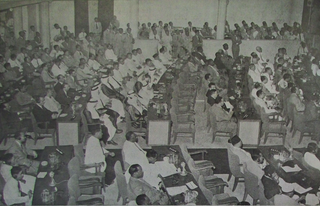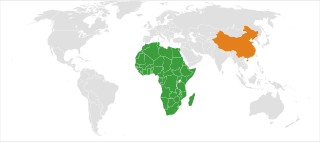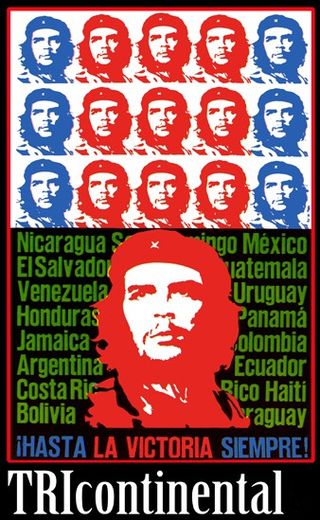
China, officially the People's Republic of China (PRC), has full diplomatic relations with 180 out of the other 192 United Nations member states, Cook Islands, Niue and the State of Palestine. As of 2024, China has had the most diplomatic missions of any state.
The Five Principles of Peaceful Coexistence are the Chinese government's foreign relations principles first mentioned in the 1954 Sino-Indian Agreement. Also known as Panchsheel, these principles were subsequently adopted in a number of resolutions and statements, including the preamble to the Constitution of the People's Republic of China.

The Sino-Soviet split was the gradual deterioration of relations between the People's Republic of China (PRC) and the Union of Soviet Socialist Republics (USSR) during the Cold War. This was primarily caused by doctrinal divergences that arose from their different interpretations and practical applications of Marxism–Leninism, as influenced by their respective geopolitics during the Cold War of 1947–1991. In the late 1950s and early 1960s, Sino-Soviet debates about the interpretation of orthodox Marxism became specific disputes about the Soviet Union's policies of national de-Stalinization and international peaceful coexistence with the Western Bloc, which Chinese leader Mao Zedong decried as revisionism. Against that ideological background, China took a belligerent stance towards the Western world, and publicly rejected the Soviet Union's policy of peaceful coexistence between the Western Bloc and Eastern Bloc. In addition, Beijing resented the Soviet Union's growing ties with India due to factors such as the Sino-Indian border dispute, and Moscow feared that Mao was too nonchalant about the horrors of nuclear warfare.
Peaceful coexistence was a theory, developed and applied by the Soviet Union at various points during the Cold War in the context of primarily Marxist–Leninist foreign policy and adopted by Soviet-allied socialist states, according to which the Socialist Bloc could peacefully coexist with the capitalist bloc. This was in contrast to the antagonistic contradiction principle that socialism and capitalism could never coexist in peace. The Soviet Union applied it to relations between the western world, particularly NATO countries, and nations of the Warsaw Pact.

The Cold War (1962–1979) refers to the phase within the Cold War that spanned the period between the aftermath of the Cuban Missile Crisis in late October 1962, through the détente period beginning in 1969, to the end of détente in the late 1970s.

Third-worldism is a political concept and ideology that emerged in the late 1940s or early 1950s during the Cold War and tried to generate unity among the nations that did not want to take sides between the United States and the Soviet Union. The concept is closely related but not identical to the political theory of Maoism–Third Worldism.

The first large-scale Asian–African or Afro–Asian Conference —also known as the Bandung Conference—was a meeting of Asian and African states, most of which were newly independent, which took place on 18–24 April 1955 in Bandung, West Java, Indonesia. The twenty-nine countries that participated represented a total population of 1.5 billion people, 54% of the world's population. The conference was organized by Indonesia, Burma (Myanmar), India, Ceylon, and Pakistan and was coordinated by Ruslan Abdulgani, secretary general of the Ministry of Foreign Affairs of the Republic of Indonesia.
Sino-Third World relations refers to the general relationship between the two Chinese states across the Taiwan Strait and the rest of the Third World, and its history from the Chinese perspective.
The Burmish languages are a subgroup of the Sino-Tibetan languages consisting of Burmese as well as non-literary languages spoken across Myanmar and South China such as Achang, Lhao Vo, Lashi, and Zaiwa.

Sino–African relations, also referred to as Africa–China relations or Afro–Chinese relations, are the historical, political, economic, military, social, and cultural connections between China and the African continent.

Algeria and Indonesia established diplomatic relations in 1963. The relationship is mostly founded on common religious and anti-colonialism solidarity, as Indonesia and Algeria are Muslim-majority countries that also once fell under colonialism. Algeria recognized Indonesia's role on supporting their country on gaining independence in 1962. Both countries agreed on expanding cooperations and strengthening relations. Algeria has an embassy in Jakarta that also accredited to Singapore and Brunei, while Indonesia has an embassy in Algiers. Both nations are members of the Non-Aligned Movement, Group of 77 and Organisation of Islamic Cooperation (OIC).
The Asian American Movement was a sociopolitical movement in which the widespread grassroots effort of Asian Americans affected racial, social and political change in the U.S., reaching its peak in the late 1960s to mid-1970s. During this period Asian Americans promoted anti-war and anti-imperialist activism, directly opposing what was viewed as an unjust Vietnam war. The American Asian Movement (AAM) differs from previous Asian American activism due to its emphasis on Pan-Asianism and its solidarity with U.S. and international Third World movements such as the Third World Liberation Front.
Izumi Hoshi is a Japanese scholar of Tibetan linguistics at the Tokyo University of Foreign Studies. Born in Chiba, she is the daughter of the equally noted Tibetan linguist Michiyo Hoshi.

Africa–Soviet Union relations are the diplomatic, political, military, and cultural relationships between the Soviet Union and Africa from the 1945 to 1991. The Soviets took little interest until the decolonisation of Africa of the 1950s and early 1960s which created opportunities to expand their influence. Africans were not receptive to the Soviet model of socio-economic development. Instead, the Soviets offered financial aid, munitions, and credits for purchases from the Soviet bloc, while avoiding direct involvement in armed conflicts. Temporary alliances were secured with Angola and Ethiopia. The 1991 dissolution of the Soviet Union left its successor state, Russia, with greatly diminished influence.
The 1957 African Asian Peoples' Solidarity Conference, also known as the "Cairo Conference", was held from December 26, 1957 to January 1, 1958 in Cairo, Egypt. Participants discussed international cooperation and geopolitics. This conference reaffirmed the ten principles from the Bandung Conference and added four more exclusive principles, mostly about nuclear affairs.

The Tricontinental Conference was a gathering of countries that focused on anti-colonial and anti-imperial issues during the Cold War era, specifically those related to Africa, Asia, and Latin America. The conference was held from 3rd to 16 January 1966, in Havana, Cuba and was attended by roughly 500 delegates from 82 different countries. It founded the Organization of Solidarity with the People of Asia, Africa and Latin America (OSPAAAL). The key issues discussed at the conference were countries that were in midst of revolutions, with a specific focus on Cuba and Vietnam.
Second Summit Conference of Heads of State or Government of the Non-Aligned Movement on 5–10 October 1964 in Cairo, United Arab Republic (Egypt) was the second conference of the Non-Aligned Movement which followed the Belgrade Conference of 1961 and preceded the Lusaka Conference of 1970. The city of Cairo was selected as a host of the summit conference at the preparatory meeting held in Colombo, Ceylon, on March 23, 1964. At the beginning of the conference the chairmanship of the Movement was transferred from the President of Yugoslavia Josip Broz Tito to the President of Egypt Gamal Abdel Nasser.
Lotus was a trilingual political and cultural magazine which existed between 1968 and 1991. The magazine with three language editions was published in different countries: Egypt, Lebanon, Tunisia and German Democratic Republic. It contained one of the early postcolonial literary criticisms employing non-Eurocentric modes.
The Afro-Asian Film Festival (AAFF) was an International film festival which was held in Tashkent, Cairo, and Jakarta during 1958, 1960, and 1964 respectively. The first Afro-Asian Film Festival took place in Tashkent, Uzbekistan in 1958. A total of 14 Asian and African countries participated, along with eight other Soviet Asian nations.
The Japan–China Trade Agreement of 1974 served as a continuation of various treaties between the People's Republic of China (PRC) and Japan during the Cold War. The treaty was an important step in the normalization of relations between China and Japan, after diplomatic and economic ties had been formally re-established via the 1972 Japan–China Joint Communiqué. The talks were headed by China's Minister of External Trade and eventual Premier, Zhou Enlai (1898–1976), and Japan's Prime Minister, Tanaka Kakuei (1918–1993). The treaty was successful due to China's road to internationalism after 1972, followed by a series of diplomatic treaties, such as the Japan-China Aviation Pact, the Maritime Agreement, the Fisheries Agreement, and the Trade Mark Protection Agreement, concluding with the official Japan-China Peace and Friendship Treaty of August 1978.



















